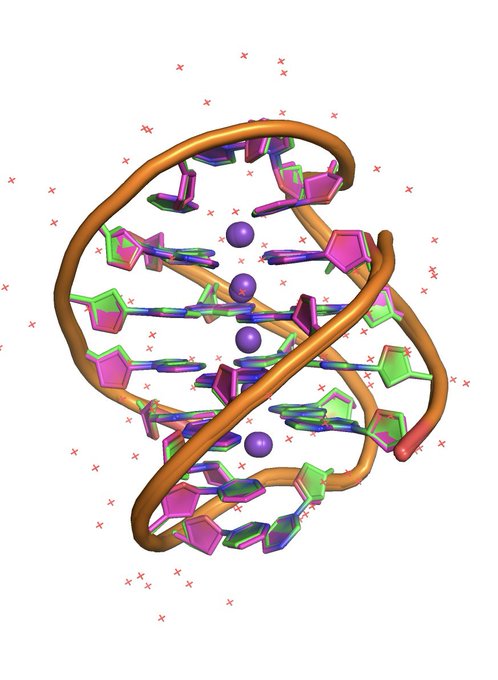I read a lovely post on how AF3 can predict electrolyte RDFs. So I digress from protein-NA complexes to just NA complexes. (Will come back to it)
Case 3: 1JRN oxytricha bimolecular G4T4G4. My fav since I solved it.
Perfect prediction with loops and 5 ions.
1
3
25
Replies
After reading about what Alphafold3 can do all day yesterday, I have designed a series of 10 attempts (max daily limit) that I will try out today. I shall push AF3 limits on non-canonical nucleic acids-protein complexes. Will keep posting results as they appear.
2
50
345
Case 1: PDB 2QNC. A DNA Holliday junction in complex with T4 endo IV resolvase.
Amazingly AF3 predicts the complex within 1.3A. The protein is spot on although one arm is slightly splayed outwards. Not unexpected as this protein was used in training.
Pink-AF3
Green-2QNC
1
2
20
As a result, AF3 (pink) is clueless about the base pairing. It randomly starts placing bases. An incorrect purine:pyrimidine swap occurs.
2
2
21
The most important part is the junction. There are certain structural rules that govern how and what sequences form the junction. They all break down in the AF3 prediction (pink).
2
2
21
Case 2: what happens if you change the sequence of DNA to equal length?
The protein again is perfectly predicted, however the DNA becomes long rods.
1
1
14
This got me thinking: how about the human telomeric sequence that forms 6 different topologies
Case 4: 1KF1 The intramolecular 21mer
Pretty impressive so far.
1
2
18
we know from experiments that telomeric G4 can adopt multiple topologies
Case 5: 2HY9
Incorrect prediction. The strand polarity changes and AF3 pushes towards propeller instead of hybrid1
1
4
21
How does it fare with bimolecular telomeric RNA
Case 6: 3IBK Telomeric RNA
The G4 backbone fits well, however there is a bit of wobbling of bases in the loops.
So far, so good since the model would be trained on these systems.
1
1
15
What if I trick AF3. Change a BrU to T in one of the bimolecular structures which AF3 has never seen before.
Case 7: 1K8P bimolecular human telomeric G4
AF3 goes crazy. It now predicts 2 hexads and 1 AT tetrad.
1
4
16
Attempt 8, was wasted on 3SC8. I should have known better that all G4 structures with ND compounds will be predicted parallel stranded. What a cheap waste of precious resources :0)
Oh well, on to the next difficult case.
1
0
11
What if I give it the telomeric G4-duplex hybrid that AF3 has never seen before.
Case 9: 5DWX
It predicts the duplex part and the G-Stem correctly but has no clue what to with the super important loops. However if I give it what it saw in training, it gives a perfect fit.
1
1
13





















